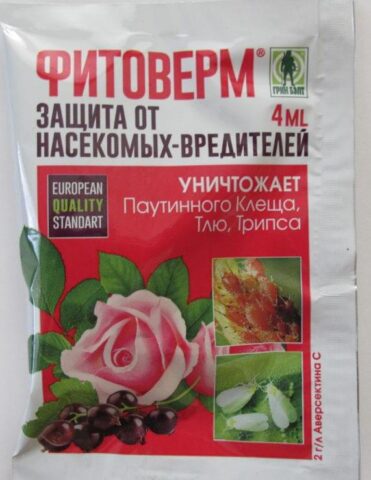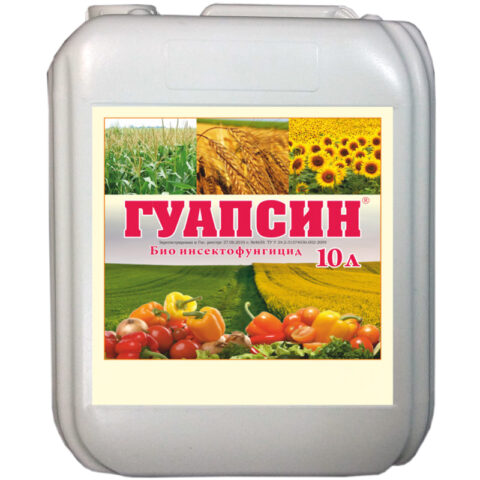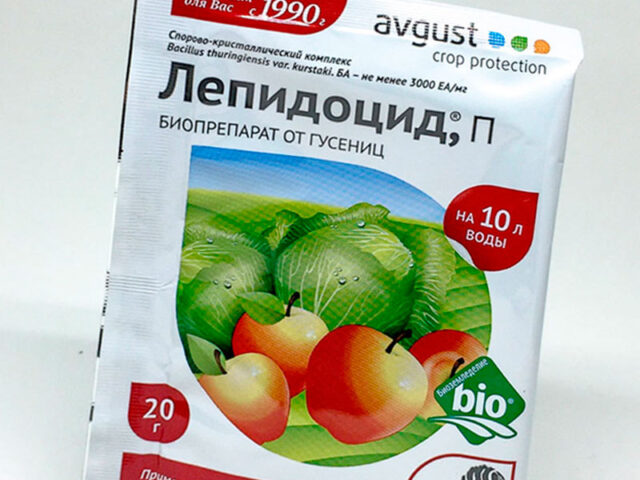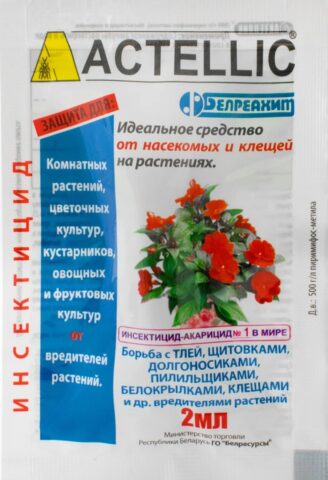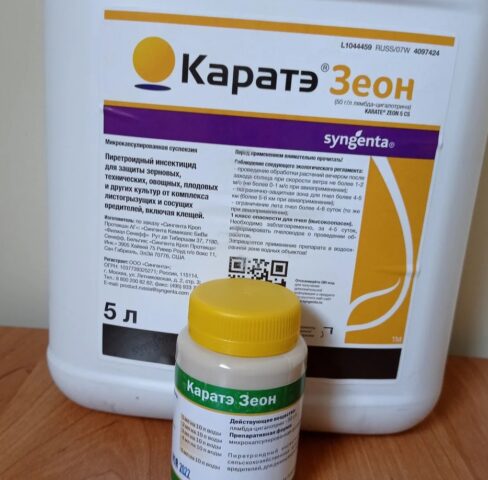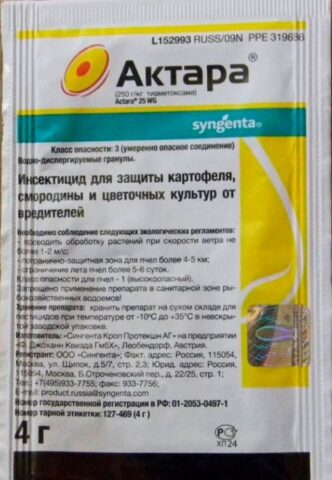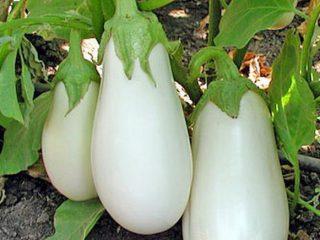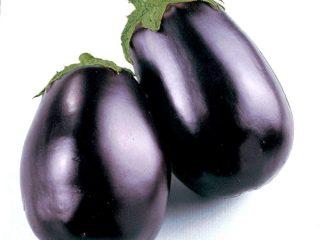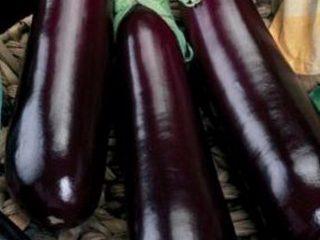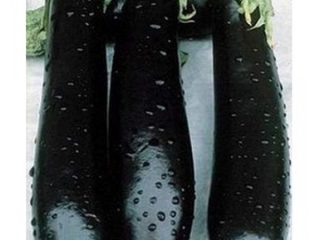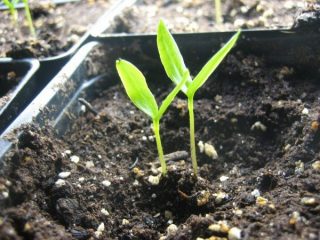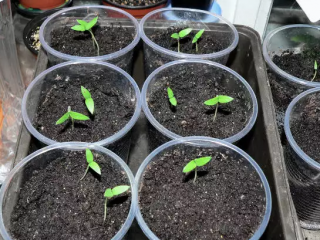Content
Eggplants, like all garden crops, are susceptible to attack by pests. If protection measures are not taken in a timely manner, there is a risk of being left without a harvest. Eggplants can be treated against pests using biological, chemical and folk remedies, depending on the stage of development. Also, to reduce the likelihood of damage, agrotechnical measures should be used. All this together helps to minimize the damage caused to plants by pests and guarantees a good harvest at the end of the season.
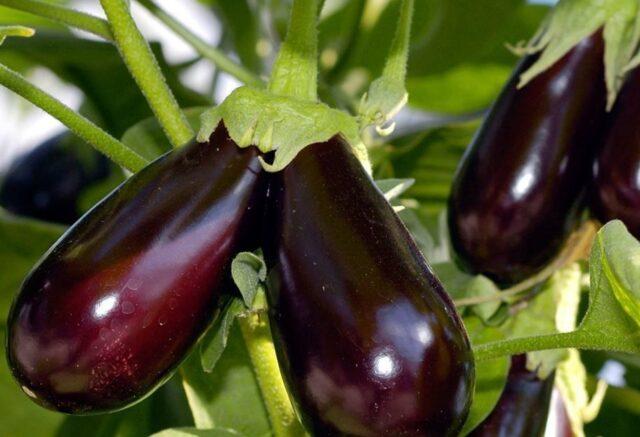
Eggplants are a favorite treat for many pests.
How to control pests on eggplants
To protect this heat-loving crop from insect invasion, you need not only to use the right means, but also to be able to recognize damage at the initial stage. To do this, you need to study the description with photos of the main pests of eggplant seedlings. After all, insects are capable of infecting not only the above-ground, but also the root system of plants.Because the volume and quality of the harvested fruits depend on how timely the pest control of eggplants is carried out.
Colorado beetle
This arthropod insect of the leaf beetle family causes serious damage to the above-ground parts of eggplants. The pest's body size is about 10 mm. The insect has a bright yellow or orange color. The pest's pronotum has dark spots, and the elytra have five black stripes.
The Colorado potato beetle (Leptinotarsa decemlineata) is distinguished by its gluttony and high fertility. Adults and larvae destroy leaves, petioles and even stems of eggplants.
The insect overwinters in the soil at a depth of 20-30 cm, and by the end of spring its active flight and mating season begins. After 2-3 days, the females lay eggs on the underside of the eggplant leaves. After 5-17 days, larvae emerge from them.
To combat the Colorado potato beetle, it is recommended to use insecticides when there is a mass appearance of offspring. Moreover, you need to spray eggplants several times, alternating the preparations, since the pest is highly resistant to poisons. Also, to reduce the number of wintering insects, deep autumn plowing is recommended.
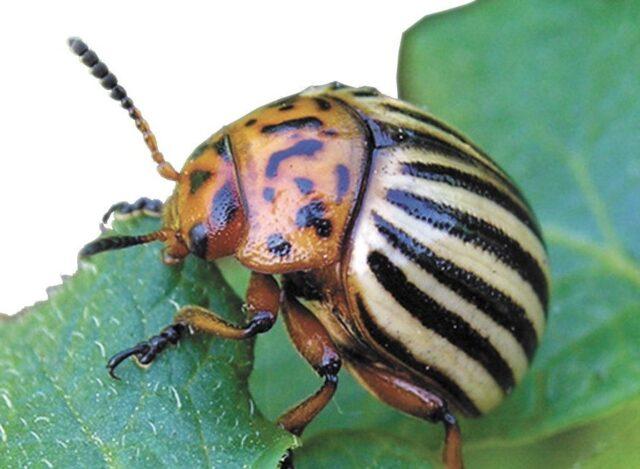
The Colorado potato beetle is a carrier of viral and bacterial diseases
Thrips
This pest is distributed throughout the world. It is distinguished by an oblong body, the length of which is from 0.5 to 1.5 mm. Thrips feed on the juice of eggplant leaves. This leads to deformation of the plates, slower development and reduced yield.
The life cycle of the pest is 30 days. During the season, 3-4 generations of thrips appear.Increased activity of the pest is observed at temperatures of +20-25 ° C and low humidity.
To combat thrips, you should use chemical and biological products at the first signs of damage, and also water the eggplants with insecticides, since the larvae go to the top layer of soil before the stage of transformation into an adult. Regular irrigation of bushes, timely weeding, and compliance with crop rotation help reduce the number of this pest.
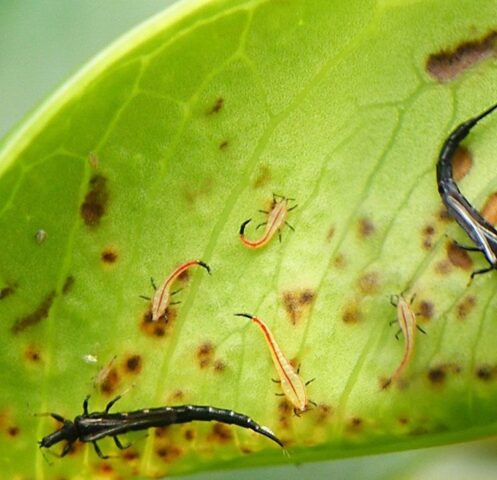
Thrips die at temperatures above +40 °C
Aphid
This pest is a small insect whose body length is from 1 to 10 mm, depending on the species. Aphids (Aphidoidea) feed on the juice of only young leaves and shoots of eggplants. It forms entire colonies that can cause serious damage to a crop in the absence of control measures.
The danger of the pest also lies in the fact that its waste products are a favorable environment for the proliferation of sooty fungus, which interferes with photosynthesis. Aphids become active at temperatures above +15 °C. Up to ten generations of this pest appear per season.
Aphids need to be controlled by spraying eggplant bushes with insecticides and biological products when the first signs of damage appear. Agrotechnical measures should also be applied.
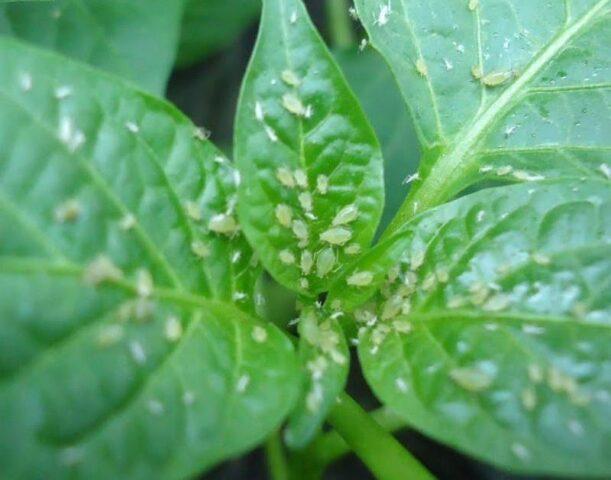
There are about five thousand species of aphids in nature
Spider mite
This is a small pest that is difficult to see with the naked eye. The spider mite (Tetranychus urticae) feeds on the cell sap of many plants, including eggplants. The lesion can be recognized by small light dots that are concentrated along the edges of the leaves. Subsequently, the plant takes on a dejected appearance, its growth stops, and small cobwebs appear on the tops of the shoots.
This pest often appears on eggplant seedlings on a windowsill, in a greenhouse, and also in the summer in open ground during a long absence of rain.
To combat it, you need to use acaricides, spraying the above-ground parts of the plants twice at intervals of once a week. It is also recommended to dust the bushes with folk remedies to prevent damage.
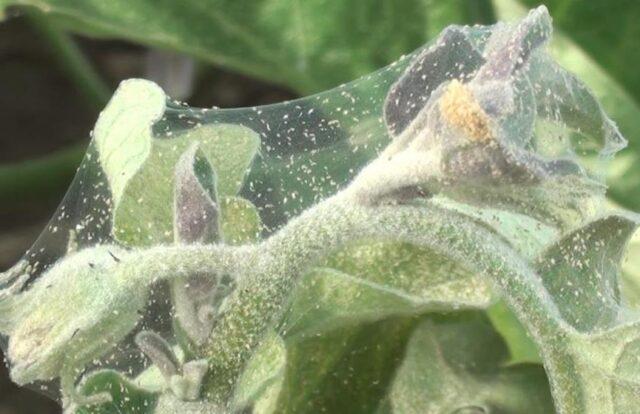
Spider mites are activated at elevated temperatures and low humidity
Scoops
This pest causes damage to eggplants at an early stage of development, which leads to their death. Cutworms (Noctuidae) are small butterflies with a length of 2 cm and a wingspan of 3.5-5 cm. Females are larger than males. The forewings of cutworms are brown with dark spots.
Damage to eggplants is caused by brown cutworm caterpillars. They eat the juicy shoots of eggplants from the inside, and also feed on leaves and fruits. The larvae are nocturnal, and during the daytime they hide in the top layer of soil. During the season, 1-2 generations of armyworms appear.
To combat these pests, it is necessary to spray and water eggplants with insecticides 2-3 times with a break of seven days, as well as regularly loosen the soil at the base of the bushes and remove weeds in a timely manner, as well as observe crop rotation.
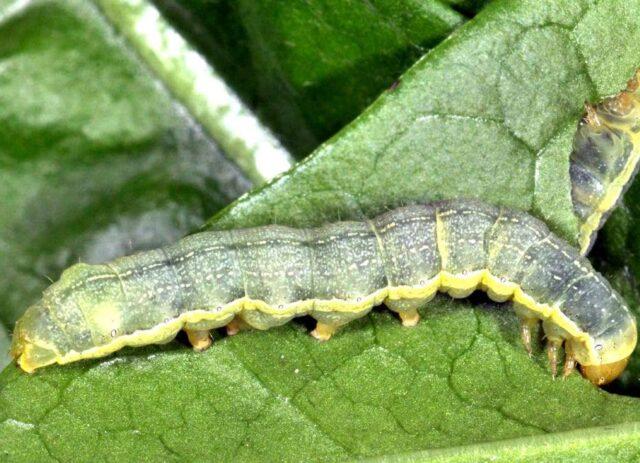
Eggplants suffer mainly from winter and exclamation cutworms.
Whitefly
This heat-loving insect most often attacks seedlings in home and greenhouse conditions. Its appearance is provoked by high humidity combined with high temperature. The whitefly (Aleyrodidae) is a flying insect that resembles a midge in appearance. Its size reaches 5 mm. The peculiarity of this pest is that its body and wings are white, which is why it got its name.
You can identify the lesion if you touch the eggplant seedlings. In this case, a swarm of whiteflies flies up. Adult pests and larvae feed on plant sap, which weakens them and makes them susceptible to disease.
It is necessary to combat this pest comprehensively. To do this, it is necessary to water and spray the eggplants with insecticides every seven days until the signs of damage completely disappear. You should also control watering and regularly loosen the soil at the base of the plants.
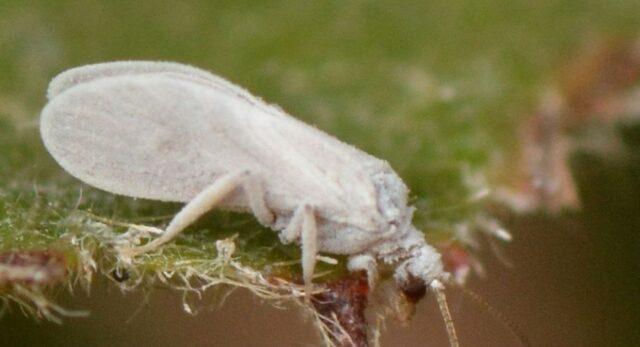
It is easier to prevent the appearance of whiteflies than to fight them later
Medvedka
This is an underground pest that feeds on soil insects. In the process of its life activity, it makes moves that disrupt the growth of the eggplant root system. The mole cricket (Gryllotalpidae) is a large insect whose body size is 6-8 cm. The pest has a hard shell on its chest, two pairs of limbs and long scaly wings. The body color is dark brown.
The mole cricket lives in the ground at a depth of 10-15 cm. It comes out only at night. It is very difficult to catch this pest, since it flies well, swims and digs quickly. The life cycle lasts 1.5-2 years.
To combat this pest, it is recommended to use toxic baits, which should be placed in the holes when planting eggplants. Crushed eggshells also help get rid of the invasion.
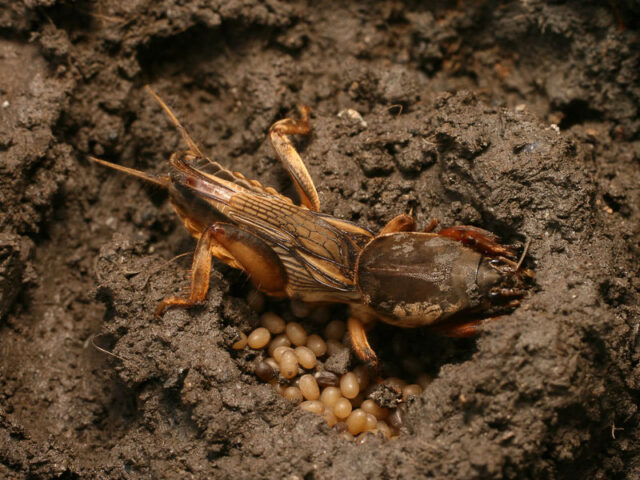
Mole cricket prefers areas rich in organic matter
Slugs
These gastropods feed on young leaves and shoots of eggplants.The size of slugs varies from 5 to 7 cm. Every day they absorb food significantly more than their own body weight. Slugs (Biobest) are nocturnal and prefer to live in damp places.
To control pests, you should sprinkle the soil at the base of the eggplants with metaldehyde-based preparations, and also use wood ash and crushed eggshells.
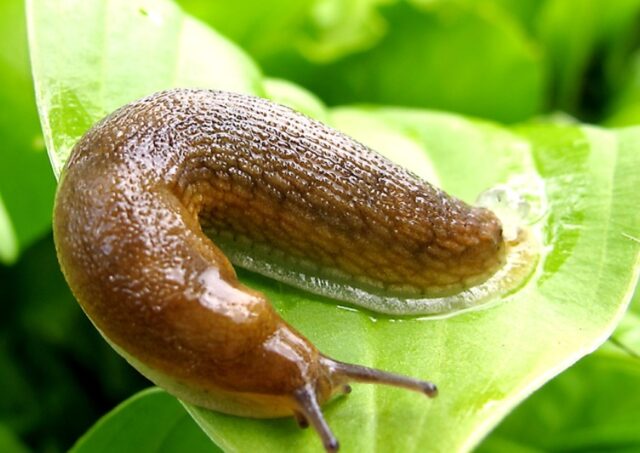
Slugs are characterized by increased fertility and low susceptibility to insecticides
Cruciferous flea beetle
This pest is a flying beetle, ranging in size from 0.15 to 0.3 cm. There are many types of cruciferous flea beetle (Phyllotreta crusiferae), differing in the color of the elytra. Damage to eggplants is caused by pest larvae that live in the top layer of soil and eat thin roots.
To combat adult pests, it is recommended to spray the plants with special preparations and folk remedies, and to combat the larvae, you need to water the eggplants against pests with an insecticide solution.
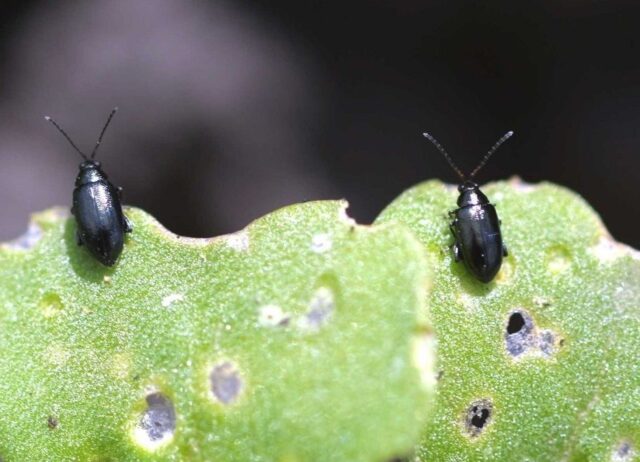
The cruciferous flea beetle can be striped, black or with a metallic sheen
How to protect eggplants from pests
To protect eggplants from pest invasion, it is necessary to use different methods of controlling them. Only in this case can damage be reduced and yields maintained at a high level.
Biological agents
The basis of these drugs are microorganisms or substances produced by them, which have a detrimental effect on pests. They help protect eggplants from mites, caterpillars, adults and larvae. The active substances included in their composition, penetrating into the insect’s body after eating the treated plant, accumulate and cause intoxication.
Such funds include:
- Fitoverm;
Fitoverm is an insectoacaricide that protects against 20 types of insects
- Guapsin;
Guapsin has insecticidal and fungicidal effects
- Lepidocide.
Lepidocide – not effective against spider mites
Chemicals
These products help quickly solve the problem and dramatically reduce the number of pests. However, during repeated treatments it is necessary to alternate them, as they can cause addiction in insects.
The most effective chemicals:
- Aktellik;
Actellik – contact organophosphorus insectoacaricide
- Confidor Extra;
Confidor Extra has a long-lasting protective effect
- Karate Zeon;
Karate Zeon – UV and rain resistant
- Aktara.
Aktara – suitable for watering and spraying eggplants
Traditional methods
Folk remedies can also be used against pests on eggplants. They are suitable for preventing damage, as well as when the number of insects is small.
Effective recipes:
- Potato tops. Cut 250 g of nightshade shoots, add 1 liter of water and boil for 15 minutes. After the product has cooled, it needs to be strained. Spray the eggplant broth against pests, but first dilute it with water in a ratio of 1:5.
- Hot peppers. Grind 100 g of pods. Pour 1 liter of water and boil for an hour. When the product has cooled, pour it into a dark bottle and leave for a day. Before use, the resulting concentrate must be diluted with water 1:10, and then the eggplant seedlings must be treated against pests.
- Garlic. You need to chop four cloves and pour the resulting mass into 1 liter of warm water. After a day, strain the infusion.Treat eggplants with pest control if insects eat the leaves.
Agrotechnical measures
Simple agrotechnical practices also help reduce the likelihood of eggplants being damaged by pests. But their effectiveness directly depends on the regularity of their implementation.
Main events:
- deep plowing of the site for the winter;
- mulching plantings with wood ash, dried nettles, spruce needles;
- compliance with crop rotation;
- planting marigolds, calendula, and garlic around the perimeter of the beds;
- destruction of plant residues after harvesting.
Conclusion
Eggplants should be treated for pests in a timely manner when the first warning signs appear. Experienced gardeners also recommend soaking the roots of seedlings in an insecticide solution before planting them in the garden in order to protect them at the initial stage of growth and allow them to grow stronger. Only by using different methods of protection can this crop be protected from pests.
